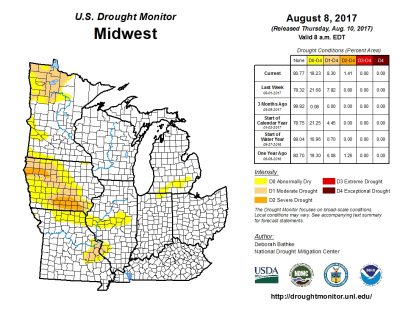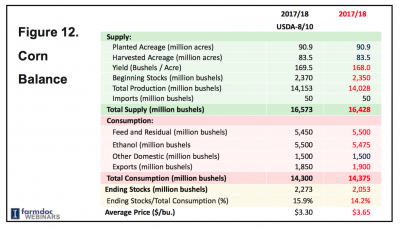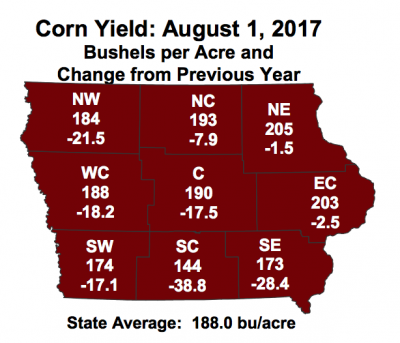The Agriculture Department has finalized some revisions to two major farm commodity programs, including rules for adding new base acres, but signup for the programs won’t be scheduled until after…
Lawmakers Hear a Variety of Farm Bill Concerns- Localized Drought an Issue
Lawmakers are hearing a variety of Farm Bill concerns from constituents and agricultural interest groups as work on formulating policies for the reauthorization of the omnibus measure continues. Today’s update looks at recent news articles that highlight some of these issues, including the negative ramifications of localized drought in North Dakota and parts of Iowa.
P.J. Griekspoor reported last week at Kansas Farmer Online that, “Kansas Rep. Roger Marshall, who is a member of the House Agriculture Committee, was with his fellow committee members as they held field hearings on the 2018 Farm Bill in Texas and Minnesota during the first days of August.
The article quoted Rep. Marshall as saying, “We are hearing some of the same concerns everywhere centered on the economy and low commodity process across the board. We’ve heard from farmers, lenders and Main Street businesses, and they are telling us that the downturn is beginning to cause a lot of stress on the industry. They are telling us about the importance of trade and about crop insurance as a valuable risk management tool.”

The article added that, “Marshall said that rural infrastructure, especially water and sewer and high-speed internet, were also mentioned multiple times in every geographic region.”
In her article, Ms. Griekspoor indicated that, “Marshall said he heard some talk about putting caps on payments from crop insurance, but he thinks that would be counterproductive.
“‘I think if you put caps on payments, you will wind up with some of the bigger producers deciding not to buy insurance, and removing those operations from the risk pool would cause problems for the entire system,’ he said.”
The Kansas Farmer article stated that, “[Rep. Marshall] expressed confidence that cotton producers will get help in the next farm bill, with cotton very likely to come back to Title 1.
“On the topic of nutrition, Marshall said he thinks those who suggested separating nutrition from the farm bill have ‘their thoughts stuck in a different era, maybe even a different century’ and that nutrition and agriculture are closely related and need to be linked in the legislation.
“‘I have a fellow freshman congressman from Philadelphia that I have gotten to know on the committee, and he is well aware of the nutrition needs in his community. He understands the need for a strong farm bill,’ Marshall said.”
James Herrera reported late last week at the Monterey Herald (Calif.) Online that, “Congressman Jimmy Panetta (D., Calif.); Congressman Jim Costa (D., Calif.); and ranking member of the House Committee on Agriculture, Congressman Collin Peterson (D., Minn.) ; were hearing from people in the fields of nutrition, agriculture – farmers and farmworkers, organic and conventional food producers, researchers and scientists [at an agriculture roundtable held at Hartnell College in Salinas, Calif. on Thursday].
“‘It’s important to listen to people, gather that evidence, bring it back to Washington, and continue to fight for those topics important to the Central Coast, California, and ultimately the nation,’ said Panetta.”
.@RepJimCosta: the richest nation with Ag abundance should not have hunger; SNAP WIC & nutrition programs are crucial. #HouseAgListens pic.twitter.com/JDiVBGZbSV
— CAFB (@CAFoodBanks) August 10, 2017
The article noted that, “Growers and anti-hunger advocates alike expressed strong support of the Supplemental Nutrition and Assistance Program and the Women Infants and Children programs.
“‘The organic industry is huge in this part of the world,’ said Peterson. ‘We’ve got work to do in that area, not only research, but we also have work to do to make sure standards are maintained.’
Making sure organic produce coming in from other countries meets this country’s criteria will be something we have to work on, said Peterson.
Meanwhile, a news release on Friday from Sen. Heidi Heitkamp (D., N.D.) stated that, “[Sen. Heitkamp] today wrapped up her two-day tour to hear more about how the drought has impacted farmers, ranchers, and businesses in western North Dakota and how she can work to strengthen the 2018 Farm Bill to protect farmers and ranchers, particularly during trying times.
“Heitkamp made several stops in Halliday, Richardton, and Mandan to talk about ways to strengthen in the 2018 Farm Bill to help make sure North Dakota businesses – including top flax exporters, beekeeping farms, and agriculture and banking leaders – are supported by farm programs to keep North Dakota’s agriculture economy thriving, particularly during the state’s prolonged drought. Heitkamp has been working for months to provide relief for farmers and ranchers as they weather the drought. They talked about some of Heitkamp’s key priorities which include strengthening crop insurance, bolstering agriculture research, and opening up new markets for North Dakota producers.”
The release added that, “During a roundtable discussion in Mandan, Heitkamp heard in detail from agricultural and banking leaders, as well as researchers and soil conservation districts about how the stress of the drought, compounded by already low commodity prices, is creating deep challenges across North Dakota’s farming and ranching economy.”
"The entire state [North Dakota] now has some level of dry/drought depiction." https://t.co/E1ckGQfwpI pic.twitter.com/tgLYV4L4Di
— Farm Policy (@FarmPolicy) August 10, 2017
In a related article on drought issues, Donnelle Eller reported on the front page of Saturday’s Des Moines Register that, “About half of Iowa — likely thousands of farmers, say experts — is caught in a deepening drought, with nearly 13 percent of it considered severe, the U.S. Drought Monitor shows.
“Conditions are driest in southeast and northwest Iowa.
“It’s lowering yields, drying pastures used to feed cattle and threatening farm finances.”

The Register article noted that, “Corn and soybean prices remain low, down 10 percent since July. Corn is trading around $3.20 a bushel for delivery this fall, for example.
‘The drought isn’t widespread enough to push up prices,’ [Charles Brown, an Iowa State University Extension farm management specialist] said. For Iowa farmers facing drought, ‘it’s the worst-case scenario — low prices and low yields.’

In addition, on the issue of corn prices, a farmdoc webinar from Friday included this slide of an updated corn balance sheet for both official USDA projections, as well as University of Illinois projections. The U of I numbers, in red, included a 2017/2018 average price of corn at $3.65 (see Corn Balance Slide below).

Saturday’s Des Moines Register article also pointed out that, “The federal government expects the largest soybean crop ever this year, and the third-largest corn crop, a U.S. Department of Agriculture report Thursday showed.”

But from a state perspective on corn production, a recent news release from the Iowa Field Office of the USDA’s National Agricultural Statistic Service stated that, “Corn forecasted production and yield are down in all 9 Iowa districts. Northeast Iowa is anticipated to have the highest yield in the State, with 205.0 bushels per acre. The largest decrease in production is expected in Central Iowa, down 51.2 million bushels from 2016.”

With respect to Farm Bill timing, John Herath reported at AgWeb Online that, “Senator Chuck Grassley of Iowa remains optimistic that a Farm Bill will find its way to the Senate floor before the end of the year, but he said tax reform will likely move first.
“‘That is something that’s going to help throughout the entire economy,’ Grassley said of a tax reform package while speaking on the AgriTalk radio show.
“Grassley noted the Senate has three big challenges to take up in the remainder of the year: tax reform, health care reform and the Farm Bill. Each will likely move through the committee process simultaneously, he said, but the Senate leadership has been clear that taxes are the top priority.”





